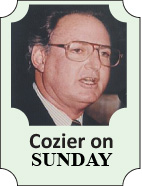There can’t be a cricketer of any generation and of any standard anywhere on the planet or any devotee of the game who hasn’t been moved by the death of Phillip Hughes.
The outpouring of grief after the Australian left-hander died in Sydney’s St Vincent’s Hospital on Thursday, two days after he was felled by a blow to the left side of the head from a bouncer in a Sheffield Shield match, has been universal and heartfelt. In the words of India’s Anil Kumble, it has “impacted the cricket world”.
The anguish, of course, is more keenly endured in Australia, not simply among those who were team mates and friends for nation and state but in every city, town and outback station across the length and breadth of that vast, prosperous and diverse country.
Hughes never played in the West Indies. It is of little consequence to those who recognize him as a fellow member of cricket’s vast and varied family.
 The West Indies Cricket Board (WICB), as did other national governing bodies, sent an appropriate message of condolence; several West Indian players used social media to air theirs. Players and umpires involved in the third round of the first-class Caribbean Professional League (CPL) on Friday wore black armbands and stood for a minute’s silence before start of play.
The West Indies Cricket Board (WICB), as did other national governing bodies, sent an appropriate message of condolence; several West Indian players used social media to air theirs. Players and umpires involved in the third round of the first-class Caribbean Professional League (CPL) on Friday wore black armbands and stood for a minute’s silence before start of play.
Teams didn’t follow New Zealand’s decision on the second day of the third Test against Pakistan in Sharjah on Friday not to send down bouncers and to set no short-leg fielders; their sentiments were no less sincere.
West Indians of a certain vintage can recall the shock, akin to Hughes’ demise, that enveloped the Caribbean after the death of Collie Smith in 1958.
Smith was an ebullient entertainer, as universally popular among colleagues and cricket’s passionate public as Hughes was half-century later.
Choosing him as one of its cricketers of the year following his standout series in England in 1957, Wisden wrote of Smith: “There is no finer sight than that of a player enjoying his cricket…(his) infectious enthusiasm and huge grin make him such an outstanding personality.”
At 26, a year older than Hughes, he was widely rated alongside Garry Sobers as an all-rounder with the potential to develop, as Sobers did, into one of the very best.
Smith lost his life when a car driven by Sobers, his close friend, collided with a 20-ton lorry outside the English town of Stoke-on-Trent. It was far from his native Jamaica and he was not playing for West Indies at the time but rather engaged in the Lancashire leagues.
At a time before the alarming, minute-by-minute details could beamed by satellite across the world, it was understandably low-key compared to the immediate and extensive television coverage of last week’s tragedy in the middle of the Sydney Cricket Ground (SCG), one of cricket’s iconic venues, that so cruelly cost the young Australian his life.
For all that, the despondency was the same throughout a region where cricket was followed with religious zeal. As with Hughes, all that mattered was that a richly talented young cricketer was taken away long before his time.
Sobers’ ultimate response to Smith’s death can be an example for Sean Abbott, the budding New South Wales all-rounder who delivered Hughes’ fateful ball.

As he acknowledges, Sobers blamed himself for Smith’s death, as Abbott might do in Hughes’ case; it is a natural reaction. He said he was so disturbed he took to drinking. He eventually got over the despair by dedicating himself to continue playing for both himself and Smith.
Even divided by two, Sobers’ final record of 8,032 runs with 26 hundreds in 93 Tests at an average of 57.78, along with 235 wickets in three different styles and 109 catches represented a reasonable return.
In the current climate of universal dejection, Abbott’s thoughts are likely to be detached from returning to the game in which he has worn Australia’s green and gold as a limited-overs player. Once he gets through this phase of doubt and reproach, as Sobers did, his image of Hughes should be one in which he is pressed to play on and to become better and better for his sake.
There is a further correlation between the accidents that took the lives of Smith and Hughes. It is precisely that they were accidents, Hughes’ has described by doctors as “a freak”.
In the aftermath of Hughes’ passing, there have been strident calls in some quarters to improve safety for batsmen. They have extended from the need for better designed helmets to tougher penalties for bowlers who exceed the limits on bouncers an over prescribed by the law to the absurdity of outlawing bouncers altogether.
The reality is that the advent of helmets during World Series Cricket in the late 1970s and the steady improvement in their design along with law changes in relation to bouncers and intimidatory bowling have rendered cricket safer than it has ever been.
The fast bowlers’ drag, that allowed them to deliver from as close as 18 yards to the batsman, was eliminated by the introduction of the front foot no-ball rule in the late 1960s.
In the 1990s, bouncers were cut to one an over, with an infringement deemed a no-ball; they were subsequently increased to two an over.
The law on “dangerous and unfair” bowling is unequivocal.
It states: “The bowling of fast short pitched balls is dangerous and unfair if the bowler’s end umpire considers that, by their repetition and taking into account their length, height and direction, they are likely to inflict physical injury on the striker irrespective of the protective equipment he may be wearing. The relative skill of the striker shall be taken into consideration.”
None of the informed reports from the SCG the day Hughes was hit made even the merest mention that this regulation was breached. Undoubtedly it has been on other occasions; it is the responsibility of the umpires to ensure that it isn’t.
In short, it was a cruel stroke of fate that ended Hughes’ innings, and life, at 63 not out as it was Collie Smith’s 56 years earlier.
There is no guarantee that it won’t happen again. Indeed, Pakistan opener Ahmed Shehzad’s skull was fractured by a ball from New Zealand’s fast-medium Corey Anderson in the first Test in Abu Dhabi just two weeks earlier; he was helmeted and well and truly set with 176 to his name. He said he “froze” on learning of Hughes’ injury.
With better protective gear and stricter laws, batsmen are more secure than they have ever been. The one drawback, as noted by the ever sprightly, 89-year-old Sir Everton Weekes when I spoke to him last week, is that it tends to lead them into a false sense of security. In an era long before helmets, he himself never took a blow to the head while compiling 4,455 runs and 15 hundreds in 48 Tests.
As with the advance in protection for batsmen, so it goes as well for safeguards for car drivers and passengers. Modern technology has endured that vehicles have become increasingly safer; motorways and highways have multiplied. Laws have become more stringent.
For all the improvements, every batsman who fronts up to fast bowling in the middle or hops into an automobile places himself in some danger; they are always potential victims of car crashes and damaging blows to the head.
To eliminate the risks altogether is an impossibility. Thankfully, as universally shocking as they are with Phil Hughes now and were with Collie Smith 56 years ago, fatalities are rare.








